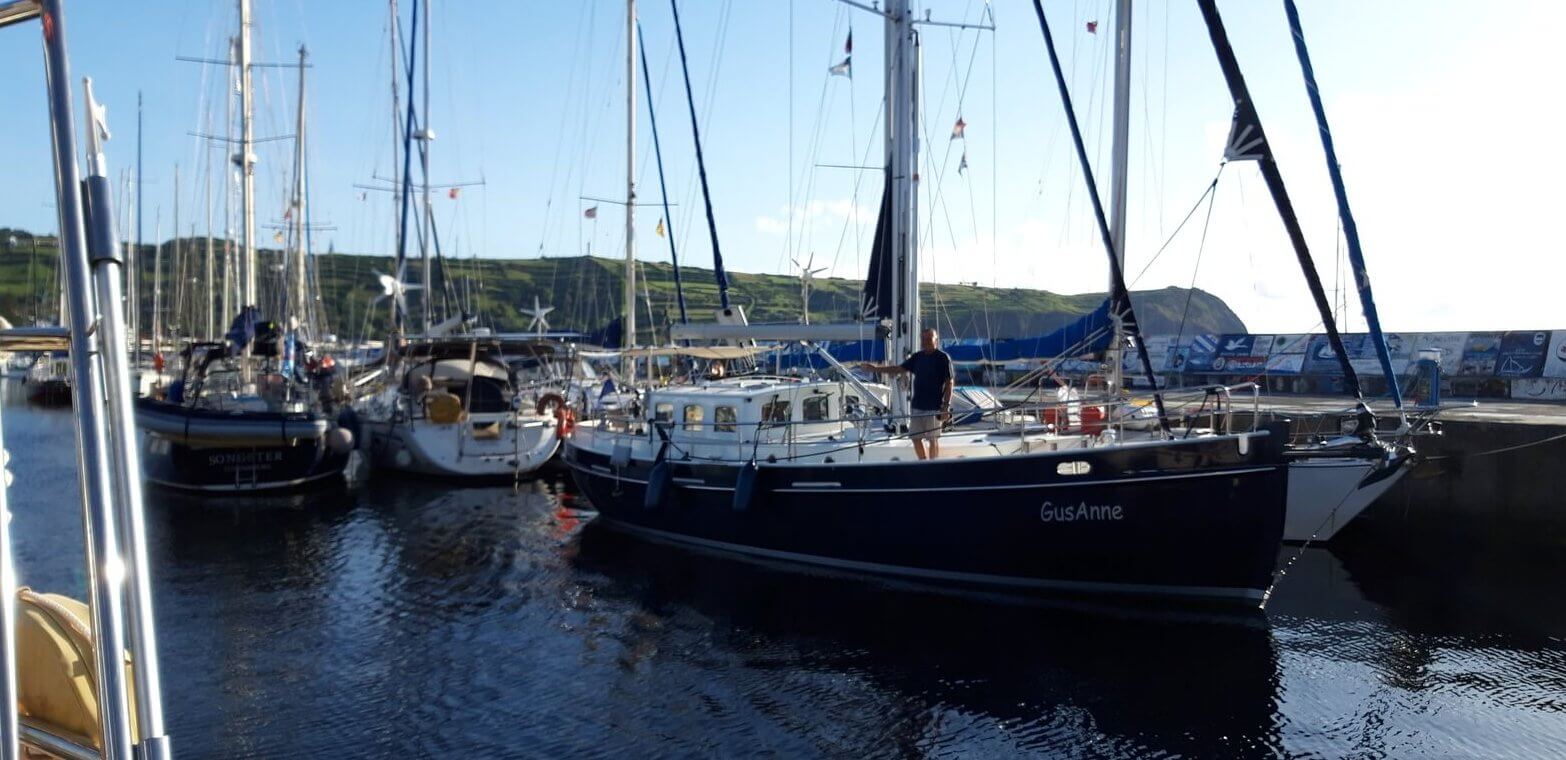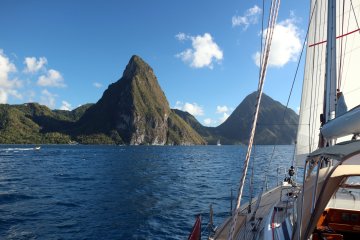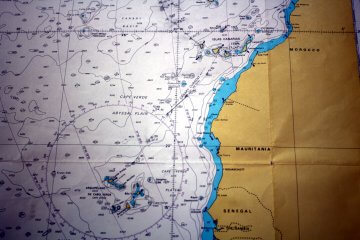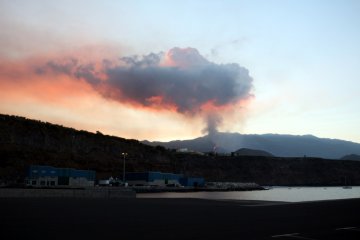After a last nice evening in Horta with Guus and Anneke (the Dutch couple) it is time to say goodbye and leave for the last island São Miguel. After a beautiful trip along the island of Pico with some whale watching (mainly Pilot whales and Atlantic Spotted dolphins) we reached Ponta Delgada on August 1st at noon. As usual we had to register and show our vaccination documents before we got a great berth in the harbour.

São Miguel is the largest island of the Azores and also probably the most visited.
Ponta Delgada itself is quite busy and we had to get used to the many tourists.
Sete Cidades is a breathtaking volcanic crater landscape in the west of the Azores island São Miguel with embedded lakes in steep crater walls.
It is wonderful! There is also a public campsite there. So we arrived there with the help of a (cheap) taxi from the marina complete with backpack and tent. The place is completely idyllic; terraced with a view of the lake.
First we made a small exploration tour around the lake and also swam at the end – excellent! But what was that … on the return the camp ground was completely full and it became still fuller and fuller. There was only one toilet and few cold showers outside in the open. Unbelievable…
That night we had no sleep at all. Loud music continued all night, together with shouting and screaming through until daylight. It was pointless to complain as it wasn’t just an isolated group, it was the entire campsite.
We had wondered why there were three beefy security guards who stood at the entrance. Apparently they have no real power and are only there to break up any fights that may start.
As soon as we could in the morning we packed everything away again and took a taxi back to Ponta Delgada.
Earlier, I had described the situation to a security guard and asked if it was a particular festival but he said only no it is every weekend the same – completely full and party time. Very sad we unfortunately could not explore the area there further.
Never again…
A visit to Europe’s only tea plantation Cha Gorreana was very exciting. Especially the visit to the tea factory right next to it was very exciting and informative. In the tea factory every single production step is shown and explained in detail . Black and green tea is produced. The plants have to grow for 7 years before the harvest can begin. From April to October, the tea is harvested every 2-3 weeks.
And what a surprise to see in the harbour our sister boat “Taniwani” from Harald & Beate almost right next to us. John has been in contact with Harald since the purchase of our Najad 490. The two have already sailed around the world and are pretty good advisors when it comes to any problems with “Maya”. We spent two wonderful evenings together and exchanged experiences.
Of course we also wanted to go to Furnas to the famous valley of the hot springs.
Due to its own microclimate, whose humidity and average temperature are above the average of São Miguel, some plant species grow there, such as cedars and araucarias, which do not grow anywhere else on the island. The main attraction, however, are the 23 warm to hot mineral springs with water temperatures up to 98 degrees, some of which are geysers. The volcanic activity shows itself mainly in the so-called Caldeiras – steaming places of boiling water.
So again by bus with tent, backpack and sleeping bag to the only campsite there. But this time we went there in the week after our last experience not on the weekend. And we spent 2 wonderful days here and also hiked at night to the hot springs. In the Terra Nostra Park there are hot springs, geysers and a myriad of plants. It is one of the most beautiful parks in the world with over 2500 different trees and the paths are lined with camellias, magnolias, azaleas, strelizias, hibiscus and araucarias.
After a super hike around Lake Furnas, we relaxed our tired limbs at the Poca da Donna Beija thermal spa. Along the river Ribeira dos Lameiros into which the source Poca da Donna Beija flows, a beautifully integrated into the landscape bathing area with numerous hot pools was created. We spent whole 3 hours in the different hot pool embedded in a tropical garden.
Back in Ponta Delgada it was time to plan our trip to La Palma. So gifts for the team in Marina Tazacorte to buy and pre-cook some food!
For our trip to la Palma we planned about 5 days. The weather forecast showed the first 2 days very calm weather and then increasing NE wind with F7 in the direction of La Palma.
The night watches we planned again in 4 hours rhythm. Already on the first day John had a tuna on the hook and I could freeze 3 nice big portions.
The first day trip to the island of Santa Maria was pretty windless and we motored almost all the way.
Around midnight on my shift there was suddenly a jolt and the engine came to a sudden stop . All of a sudden a lot of thoughts go through your head – did we ram a sleeping whale or is something caught in the propeller? What about the large ships sailing around us – without the engine with no wind we couldn’t move!
John shone the flashlight at the stern and there we saw a huge fishing net trailing out from under the boat. We tried for 2 hours to pull the net out (which was also very difficult to cut through) but it seemed to become longer and longer. Finally we decided that John would try to free the propeller in the morning by diving under the boat with a scuba tank.
The next morning John put on the diving gear, dived in and managed to free the propeller in only 10 minutes. We decided to take the net with us so that animals and other sailors would not get caught in it.
It was absolutely calm and we were about 140 miles from Santa Maria. We seriously discussed turning back, because also for the next days hardly wind was to be expected and because we didn’t have enough fuel to get all the way to La Palma. After some more calculations we decided to go on and wait for the wind to come. And we wanted to try our cruising sail with the newly fitted “sock”.
This “sock” slides over the entire sail and [should] make using this very large sail much easier.
After 2 hours of preparation and frustration we finally had the sail up. The new sock proved its’ worth allowing us to relatively easily set the sail.
We sailed for almost 8 hours and made 2-5 knots. The fascinating thing was the sailing was almost silent, and with the absolute silence in the middle of the Atlantic was surreal. The next 2 days were beautiful sailing weather. We caught a large Dorado but then we lost it just before getting it on the boat. We were about 60 miles from La Palma when the wind increased from F7 to F8 and the waves also increased to a height of 3m. It became more and more towards evening and we decided to change direction and John steered to avoid the waves.
The last 6 hours were exhausting and it was a struggle to stay awake. Finally at 0230 we reached the marina in Tazacorte and were happy when we could moor “Maya” at the jetty. After an extensive shower we fell dead tired into the bunk.
The following morning we put “Maya” back into her “usual” berth (which the marina had kindly held for us) and proceeded to unload the nasty net from the boat.
The net was quite large (and heavy). It measured nearly 9 metres long and we’re pleased we didn’t leave it in the water. The marina very kindly took the net away to we know not where!



